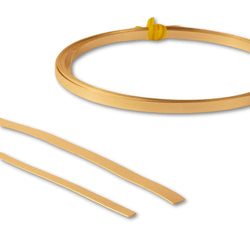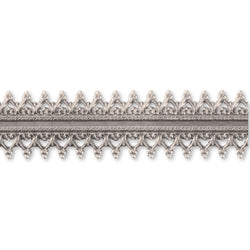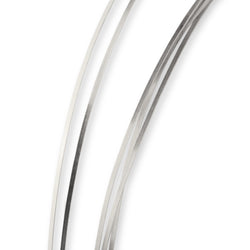Smyckesframställningsremsor
Smyckesremsor för varje projekt
Bezel Strips: Våra bezel strips är juvelerarens val för att skapa anpassade inställningar som håller ädelstenar med elegans och styrka. Dessa remsor finns i både silver- och guldlegeringar och är redo att formas runt dina unika ädelstenar, vilket säkerställer en tät och säker passform.
Cloisonné-remsor: Väck den uråldriga konsten med emaljsmycken till liv med våra premium-finsilver och 24k finguld cloisonné-remsor. Dessa remsor är idealiska för att skapa livfulla, färgfyllda stycken, och hjälper dig att särskilja emalj eller ädelstenar på ett rent, exakt sätt och förvandla dina mönster till bärbar konst.
Präglade remsor: Textur möter stil med våra präglade remsor, perfekta för att lägga till ett taktilt element till dina smycken. De detaljerade mönstren på dessa remsor fångar ljuset och ögonen, vilket ger djup och intresse till alla delar.
Galleriremsor: Våra galleriremsor är vackert utformade, med intrikata utskärningar som ger en dekorativ kant till dina smyckesdesigner. De ger en lyxig touch till inställningar och band, vilket gör varje pjäs till ett enastående föremål.
Varje typ av remsor tjänar ett unikt syfte vid smyckestillverkning, vilket säkerställer att hantverkare och gör-det-själv-entusiaster kan hitta exakt vad de behöver för att fullborda sin vision. Kvalitet är av största vikt vid smyckesutformning, därför tillhandahåller vi endast de bästa materialen för att stödja din passion. Bläddra i vårt utbud av smyckesremsor och låt din fantasi forma de ädla metallerna till skapelser som håller livet ut.
Vanliga frågor
Ramremsor är en juvelerares häftklammer för att skapa anpassade inställningar som håller ädelstenar säkert på plats.
De är gjorda av högkvalitativa silver- och guldlegeringar, som erbjuder både styrka och formbarhet för att svepa runt stenar av alla storlekar, vilket skapar en sömlös och elegant miljö som är både funktionell och attraktiv.
Genom att inkludera ramlister kan hantverkare se till att deras ädelstenar visas upp vackert och säkert.
Galleriremsor lägger till en touch av elegans och krånglighet till smyckesdesigner. Dessa dekorativa metallremsor, tillgängliga i 925 sterling silver, har utsmyckade utskärningar och mönster som är perfekta för att kanta bitar eller lägga till dekorativa element.
Genom att använda galleriremsor från vårt omfattande utbud av smyckestillbehör kan designers lyfta sina skapelser med detaljerade kanter som fångar ljuset och lägger till ett sofistikerat inslag till varje smycke.
Absolut! Våra präglade remsor är designade för att lägga till djup och textur till dina smycken, och de kan ytterligare anpassas för att passa dina specifika projektbehov.
Med en mängd olika mönster tillgängliga är dessa remsor perfekta för att skapa enastående delar som kräver ett taktilt element.
Oavsett om du vill lägga till en djärv funktion eller subtil detalj till dina skapelser, är våra präglade remsor ett mångsidigt val som kan formas och trimmas för att passa din designvision.
Cloisonné-remsor är viktiga för att skapa det raffinerade och färgstarka emaljarbetet som kallas cloisonné, en berömd teknik för smyckestillverkning.
Dessa fina metallremsor, tillgängliga i både fint silver och fint guld, är skickligt böjda till intrikata mönster och lödda på smyckesbaser, och fungerar som avdelare som senare kommer att fyllas med emalj för att skapa levande, detaljerade mönster.
Våra cloisonné-remsor förser hantverkare och hantverkare med det högkvalitativa material som behövs för att uppnå den precision och hållbarhet som krävs för utsökt cloisonné-konstnär.
Bezel strip, also known as bezel wire is a thin piece of metal, typically sterling silver, pure silver or 9ct / 18ct gold, used to create a bezel setting around a gemstone. This strip is shaped and soldered to form a secure frame that holds the stone in place, ensuring durability and protection.
To use bezel wire for gemstone setting, first measure and cut the strip to fit snugly around the stone. Solder the ends together, shape the bezel around the stone, and then solder the bezel to the jewellery piece. Finally, use a bezel roller to gently push the wire over the stone's edges, securing it in place.
The thickness of bezel wire for cabochons typically ranges from 0.3mm to 0.5mm (28 to 24 gauge). Thicker wire provides more durability and is ideal for larger or heavier stones, while thinner wire is easier to work with and better for smaller stones.
Yes, bezel strips can be used for setting faceted stones. The bezel setting provides a sleek, modern look and securely holds the stone in place, protecting its edges. Ensure the bezel strip is thin enough to fold over the stone without obscuring its facets.
A gallery strip in jewellery making is a decorative metal strip with intricate cut-out patterns. It is used to create elegant settings for gemstones, adding both structural support and visual interest to rings, pendants, and other jewellery pieces.
Bezel wire is a solid strip of metal used to create a simple, smooth frame around a gemstone. In contrast, gallery wire is more decorative, featuring openwork patterns that add intricate details to the setting while still holding the stone securely.
To solder bezel wire without melting it, use a low-temperature solder and apply heat gradually with a torch, focusing on the area where the solder is applied. Keep the flame moving to avoid overheating any one spot, which could cause the wire to melt
Bezel strips are available in various metals, including sterling silver, fine silver, 9ct, 14ct, and 18ct gold. These options allow jewellers to choose the best metal for their design and gemstone.
Choose the right gallery wire for your project by considering the size and style of your gemstone and the overall design. For intricate designs, select a gallery wire with finer patterns. Ensure the height of the gallery wire matches the depth of the gemstone.
Gallery wire is commonly used to create decorative bezel settings for gemstones, add embellishments to jewellery pieces, and serve as an ornate edge or frame in rings, pendants, and bracelets. It enhances the visual appeal while securing the stones.
Yes, gallery wire can be used for both rings and pendants. Its versatility and decorative patterns make it suitable for various types of jewellery, allowing for cohesive designs across different pieces.
Gallery strips are available in a wide range of patterns, including floral, geometric, and lace-like designs. These patterns can vary in intricacy and size, offering options for different styles and gemstone shapes.
To secure gemstones with gallery wire, solder the wire to the jewellery base or back plate, place the gemstone inside the gallery setting, and gently push the prongs or edges of the gallery wire over the stone using a bezel roller, bezel pusher, prong pusher or a combination of all 3. Ensure the stone is held firmly without being overly tight.
A cloisonné strip is a thin metal strip used to create partitions or cells in the cloisonné enamelling process. These strips are soldered onto a metal base, and the resulting cells are filled with enamel powder and fired, creating vibrant, intricate designs.
Cloisonné strips are typically made from high-purity metals such as 24k fine gold and 9999 fine silver. These metals are chosen for their ability to withstand the high temperatures of the enamelling process and their excellent compatibility with enamel.
To prepare cloisonné wire for enamel work, clean the wire thoroughly to remove any oils or residues. Shape the wire into the desired design, solder it to the metal base, and ensure all connections are secure before applying enamel.
Best practices for soldering cloisonné strips include using a fine-tipped torch for precise heat control, applying a thin layer of flux to prevent oxidation, and soldering quickly to avoid damaging the delicate wire. Always clean the piece thoroughly before adding enamel.
The right cloisonné wire thickness depends on the design complexity and the depth of the enamel you plan to use. Typically, cloisonné wire ranges from 0.25mm to 0.5mm in thickness, with thinner wires being better for intricate designs and thicker wires providing more structural support.
Yes, cloisonné strips can be used with other types of wire, such as bezel or gallery wire, to create mixed-media jewellery pieces. Combining different wires can add texture and dimension to your designs, making them more unique and visually interesting.
An embossed strip in jewellery making is a metal strip that has been patterned or textured through a stamping or rolling process. These strips are used to add decorative elements to jewellery pieces, such as rings, bracelets, and pendants, providing a rich, textured finish.
The advantages of using embossed strips in jewellery include adding visual interest, enhancing the tactile quality of the piece, and allowing for intricate designs without the need for extensive hand engraving. Embossed strips are also available in various patterns, making them versatile for different styles.
To solder embossed strips without losing the pattern, use a lower-temperature solder and heat the piece gradually. Apply heat evenly and focus on the solder joint, avoiding direct flame contact with the patterned surface. A heat-resistant paste or soldering block can help protect the embossing during soldering.
Embossed strips are available in a wide range of patterns, including floral, geometric, and abstract designs. These patterns vary in depth and intricacy, allowing you to choose the perfect strip to complement your jewellery design.
Yes, embossed strips can be used for making rings. They add a decorative element to the band, creating a unique, textured look. Ensure the strip is properly sized and shaped before soldering to create a seamless, comfortable ring
There is no difference between decorative wire and patterned wire; they are simply different names for the same product. Both terms, along with "embossed strip," refer to wire or metal strips that have been mechanically embossed with a pattern or texture. These products are used interchangeably in jewellery making to add visual interest and texture to designs.
To create custom designs with patterned wire, select a wire pattern that complements your overall design. Use the wire to outline or accentuate key elements of your jewellery piece. You can also combine different patterned wires to create a unique, layered effect
Some of the most popular decorative wire patterns include floral and geometric patterns. These patterns add texture and dimension to jewellery pieces
Yes, decorative wire can be used for structural components in jewellery, provided it is thick and strong enough to support the design. For example, a thicker patterned wire can be used as the main band in a ring or as a sturdy frame for a pendant.
The right thickness of embossed strip depends on the design and function of the jewellery piece. Thicker strip (18-20 gauge) is ideal for structural elements, while thinner strip (22-26 gauge) is better for decorative accents and finer details.
Patterned wire is available in sterling silver, with some variations available in 9k and 18k gold.
Working with bezel strips requires a few tools, including:
Flush cutters: For cutting the bezel strip to the correct length.
Soldering setup: Including a torch, flux, and solder, for joining the ends of the bezel.
Bezel roller or burnisher: To smooth and secure the bezel around the gemstone.
Files and sandpaper: For smoothing edges and finishing the bezel. These tools help you create precise and secure bezel settings for gemstones in your jewellery designs.
To clean and maintain jewellery made with cloisonné strips, use a soft, lint-free cloth to gently wipe the surface, removing any dust or oils. For deeper cleaning, use warm water mixed with a mild soap, and gently clean the piece with a soft brush. Avoid abrasive cleaners or chemicals, as they can damage the enamel or metal. Store cloisonné jewellery in a dry, soft-lined box to protect it from scratches and humidity. Regular maintenance will keep the enamel vibrant and the metal lustrous.
The best way to store unused bezel and gallery wires is to keep them in a cool, dry place, away from direct sunlight. Pack the wires neatly to prevent kinks or bends, and store them in labelled plastic bags or compartments to keep them organised and free from dust. Consider storing them in anti-tarnish bags or adding anti-tarnish strips to the storage area to prevent oxidation. Proper storage will maintain the quality and usability of the wires for future projects.
To bend and shape bezel wire without damaging it, use the appropriate tools (Bezel Roller, Bezel Pusher) for precise control, and work slowly to avoid kinks or warping. If the wire is thick or hard, anneal it first by heating it with a torch and allowing it to cool, which makes it more pliable. Always bend the wire gradually and use a mandrel or shaping tool to achieve smooth curves. This technique helps preserve the integrity of the wire while creating the desired shape for your jewellery.
The best solder for working with fine silver and gold cloisonné strips is an enamelling solder. enamelling solder has a high melting point that provides a strong, durable bond, which is important for maintaining its structure during the enamel firing process.
To avoid warping when soldering bezel strips, evenly heat the entire piece rather than focusing the flame on a single spot. Use a soldering block to support the bezel strip and distribute heat more uniformly. Additionally, anneal the metal before soldering to relieve internal stresses that could cause warping. Applying solder sparingly and allowing the piece to cool gradually will help maintain the bezel strip's shape.
The best gauge of wire for making bezels typically ranges from 26 to 28 gauge (0.4mm to 0.3mm). This thickness provides the right balance of flexibility and strength, making it easy to bend around a gemstone while still securely holding it in place. For larger or heavier stones, you might opt for a slightly thicker bezel wire, such as 24 gauge (0.5mm), to ensure durability.




